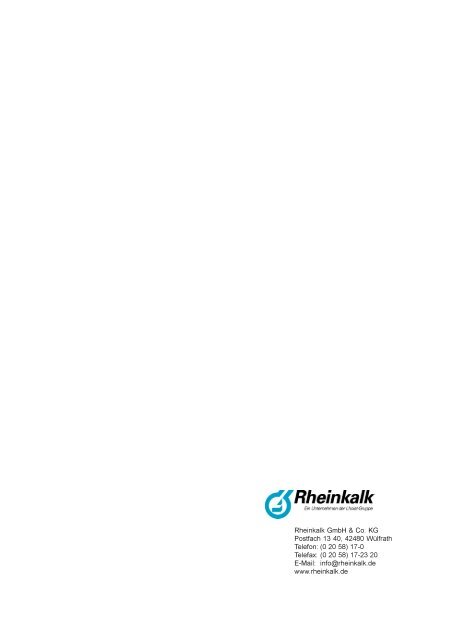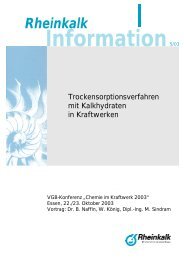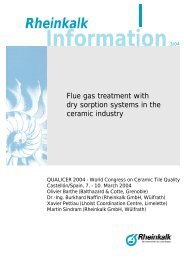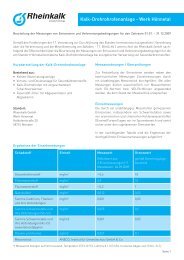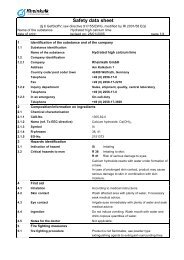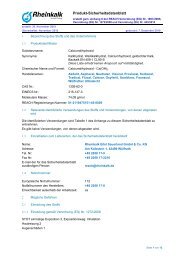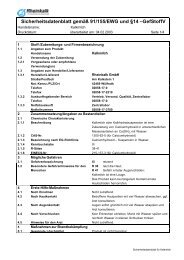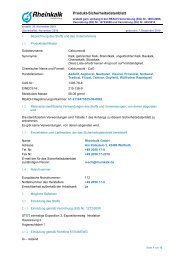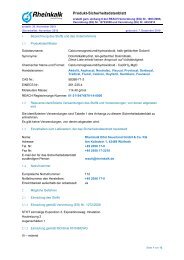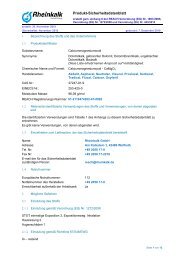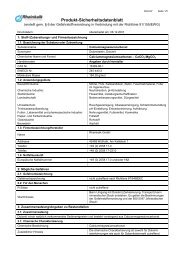SO - Rheinkalk
SO - Rheinkalk
SO - Rheinkalk
You also want an ePaper? Increase the reach of your titles
YUMPU automatically turns print PDFs into web optimized ePapers that Google loves.
In the next picture operating results from different municipal waste incineration plants<br />
are compared. By the use of the two-stage-process (MCD) it is possible to reduce not<br />
only the lime consumption between 30 – 50 % but the residue as well. The<br />
application of such a process allows very flexible operation of a flue gas cleaning<br />
system. Even peaks on the raw gas side are controllable.<br />
spec. consumption [kg/t]<br />
40<br />
35<br />
30<br />
25<br />
20<br />
15<br />
10<br />
5<br />
0<br />
MWI I (MKT)<br />
MWI II (MKT)<br />
MWI III (MKT)<br />
MWI IV<br />
MWI V<br />
→ MCD Process: Specific consumption ca. 18 - 22 kg/t waste<br />
spec. consump.<br />
Spongiacal<br />
spec. consump. HL<br />
(lime based)<br />
→ One Stage Spray Dry Sorption: Specific consumption ca. 28 - 35 kg/t waste<br />
Graph 9: Comparison of operational results<br />
Conclusions<br />
• Even in the temperature ranges previously regarded as being unfavourable for<br />
the use of hydrated lime, the removal of acid-forming pollutants, such as HCl<br />
and <strong>SO</strong>2, by means of a highly reactive additive tailored to the application case,<br />
was highly effective.<br />
• The limiting values of the 17th BImSchV were observed.<br />
• In works trials, it was proved that the use of Spongiacal ® gave reductions of<br />
more than a half in the consumption of operating materials.<br />
• This gave corresponding reductions in the amount of residual waste.<br />
• According to currently available operating experience, the use of Spongiacal ® in<br />
a MWI with a single or two-stage dry sorption plant can safely comply with the<br />
limiting values for <strong>SO</strong>2 and HCl specified in the 17th BImSchV. It is<br />
advantageous to use these products in a mixture with a carbon component for<br />
the removal of ecotoxic pollutants. This means that complicated flue-gas<br />
cleaning processes are not necessary. It also ensures an economically viable<br />
operation on a long-term basis with low expenditures of personnel, equipment<br />
and materials.<br />
• If high contents in the raw gas occur frequently, the use of the MCD process<br />
with its high effectiveness and low consumption of additives allows compliance<br />
with mandatory limiting values, even under conditions that were previously<br />
considered to be unfavourable. Moreover, this process allows operation with low<br />
expenditures of personnel, equipment and materials.<br />
8


